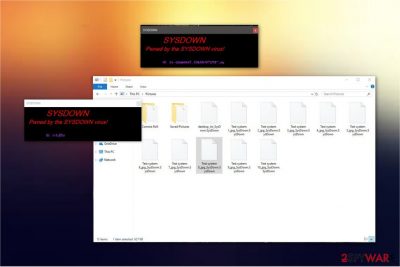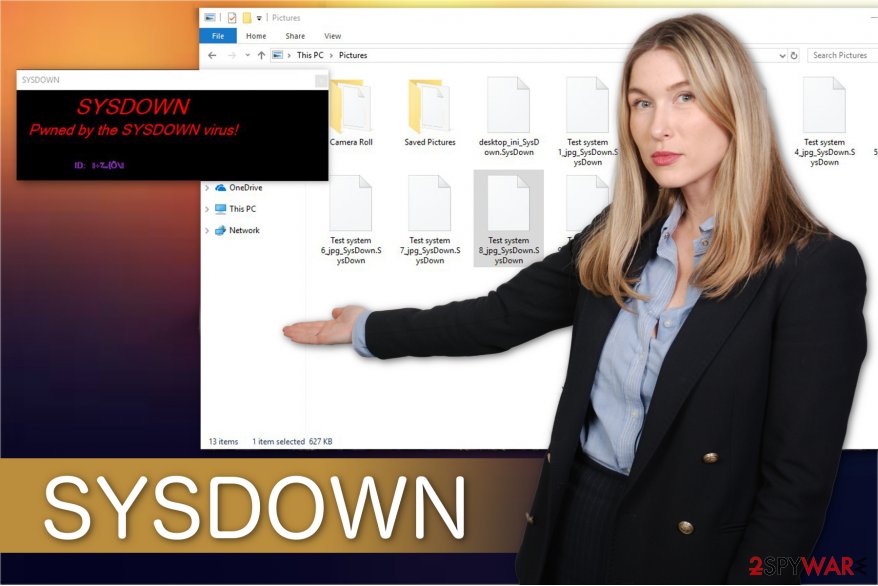SYSDOWN ransomware (Decryption Methods Included) - Removal Guide
SYSDOWN virus Removal Guide
What is SYSDOWN ransomware?
SYSDOWN ransomware is still under development

SysDown is a file-encrypting virus which was first released by Royal for testing purposes only. After data encryption, it appends .sysdown extension at the end of the file-name. However, it seems that malevolent people might exploit the malicious program for making illegal profits.
Currently, SysDown is in-development stage since its ransom note appears to be unfinished. The message only claims that the computer was infected with the ransomware. The information about the demanded amount of the ransom or contact details is not provided.
Despite the fact that SysDown ransomware is now under development, there is a strong possibility that the criminals will start distributing it online. Likewise, if you have been already infected with this computer threat, immediately take appropriate measures to protect your system from further damage.
Since SysDown virus uses AES military-grade encryption algorithms to compromise the data, it is almost impossible to generate the decryption key[1]. However, there is a possibility to use alternative recovery methods after you get rid of the ransomware from your computer.

Therefore, we strongly recommend you remove SYSDOWN as soon as possible to be able to use the alternative recovery techniques which are presented at the end of this article. For the elimination procedure, we suggest using FortectIntego. This is a reliable security software which will help you to uninstall the malicious program from your system safely.
Also, note that if you delay SYSDOWN removal, it might be updated to delete the files which are necessary in order to use alternative recovery methods or even damage your computer permanently. Likewise, we encourage you not to hesitate and terminate the virus right now.
Learn how ransomware can reach your system
Even though this malicious program was not initially distributed to infect innocent people, hackers might spread the updated version online. Since a vast of people keep on paying the ransom, criminals are motivated to release upgrades or new variants of the file-encrypting viruses.
They might distribute it with the help of spam emails which hold the malicious attachment inside. Usually, they look incredibly similar to the ones sent by legitimate companies. In fact, hackers imitate that they come from well-known brands, etc. Likewise, people are convinced to open the infected file which is attached to the email and infiltrate ransomware.
Also, another popular way to distribute file-encrypting viruses is to place them on peer-to-peer (P2P) networks where people come to seek for illegal downloads[2]. Criminals create a misleading appearance of a legitimate software/update as Adobe Flash Player which actually hides a ransomware executable inside.
Thus, we strongly advise you to avoid clicking or downloading the content which might be potentially malicious. Always double-check whether the received email corresponds to your recent activity and do not open it if you do not recall having business with the sender.
Additionally, do not download video, audio or other files illegally. If you do so, note that you have no guarantees that the file will not be malicious. Likewise, we suggest installing applications only from verified developers or official distributors. This way, you will protect your PC from potential hazards.
Terminate SysDown virus with a few clicks
Ransomware is one of the most dangerous species of the computer infections which is able to infiltrate other malware into your system. Therefore, according to DieViren.de[3] experts, you will have to employ a professional antivirus software for SYSDOWN removal procedure. Our top picks would be FortectIntego, SpyHunter 5Combo Cleaner and Malwarebytes.
These anti-malware tools will remove SYSDOWN in a few seconds. However, you might need to boot your computer into Safe Mode to download the security software. For that, follow the instructions below which will briefly explain the process. Also, check the alternative recovery methods to get back the access to the encrypted data.
Getting rid of SYSDOWN virus. Follow these steps
Manual removal using Safe Mode
Boot your PC into Safe Mode with Networking to disable the ransomware.
Important! →
Manual removal guide might be too complicated for regular computer users. It requires advanced IT knowledge to be performed correctly (if vital system files are removed or damaged, it might result in full Windows compromise), and it also might take hours to complete. Therefore, we highly advise using the automatic method provided above instead.
Step 1. Access Safe Mode with Networking
Manual malware removal should be best performed in the Safe Mode environment.
Windows 7 / Vista / XP
- Click Start > Shutdown > Restart > OK.
- When your computer becomes active, start pressing F8 button (if that does not work, try F2, F12, Del, etc. – it all depends on your motherboard model) multiple times until you see the Advanced Boot Options window.
- Select Safe Mode with Networking from the list.

Windows 10 / Windows 8
- Right-click on Start button and select Settings.

- Scroll down to pick Update & Security.

- On the left side of the window, pick Recovery.
- Now scroll down to find Advanced Startup section.
- Click Restart now.

- Select Troubleshoot.

- Go to Advanced options.

- Select Startup Settings.

- Press Restart.
- Now press 5 or click 5) Enable Safe Mode with Networking.

Step 2. Shut down suspicious processes
Windows Task Manager is a useful tool that shows all the processes running in the background. If malware is running a process, you need to shut it down:
- Press Ctrl + Shift + Esc on your keyboard to open Windows Task Manager.
- Click on More details.

- Scroll down to Background processes section, and look for anything suspicious.
- Right-click and select Open file location.

- Go back to the process, right-click and pick End Task.

- Delete the contents of the malicious folder.
Step 3. Check program Startup
- Press Ctrl + Shift + Esc on your keyboard to open Windows Task Manager.
- Go to Startup tab.
- Right-click on the suspicious program and pick Disable.

Step 4. Delete virus files
Malware-related files can be found in various places within your computer. Here are instructions that could help you find them:
- Type in Disk Cleanup in Windows search and press Enter.

- Select the drive you want to clean (C: is your main drive by default and is likely to be the one that has malicious files in).
- Scroll through the Files to delete list and select the following:
Temporary Internet Files
Downloads
Recycle Bin
Temporary files - Pick Clean up system files.

- You can also look for other malicious files hidden in the following folders (type these entries in Windows Search and press Enter):
%AppData%
%LocalAppData%
%ProgramData%
%WinDir%
After you are finished, reboot the PC in normal mode.
Remove SYSDOWN using System Restore
You can also reboot your computer to Safe Mode with Command Prompt.
-
Step 1: Reboot your computer to Safe Mode with Command Prompt
Windows 7 / Vista / XP- Click Start → Shutdown → Restart → OK.
- When your computer becomes active, start pressing F8 multiple times until you see the Advanced Boot Options window.
-
Select Command Prompt from the list

Windows 10 / Windows 8- Press the Power button at the Windows login screen. Now press and hold Shift, which is on your keyboard, and click Restart..
- Now select Troubleshoot → Advanced options → Startup Settings and finally press Restart.
-
Once your computer becomes active, select Enable Safe Mode with Command Prompt in Startup Settings window.

-
Step 2: Restore your system files and settings
-
Once the Command Prompt window shows up, enter cd restore and click Enter.

-
Now type rstrui.exe and press Enter again..

-
When a new window shows up, click Next and select your restore point that is prior the infiltration of SYSDOWN. After doing that, click Next.


-
Now click Yes to start system restore.

-
Once the Command Prompt window shows up, enter cd restore and click Enter.
Bonus: Recover your data
Guide which is presented above is supposed to help you remove SYSDOWN from your computer. To recover your encrypted files, we recommend using a detailed guide prepared by 2-spyware.com security experts.If your files are encrypted by SYSDOWN, you can use several methods to restore them:
Try Data Recovery Pro
Experts recommend using this professional tool to recover files with .sysdown extension. Additionally, you can use this software if you have lost important files due to accidental delete.
- Download Data Recovery Pro;
- Follow the steps of Data Recovery Setup and install the program on your computer;
- Launch it and scan your computer for files encrypted by SYSDOWN ransomware;
- Restore them.
Take advantage of Windows Previous Versions feature
Windows users who have previously enabled System Restore function can use the in-built feature to recover corrupted files after ransomware attack.
- Find an encrypted file you need to restore and right-click on it;
- Select “Properties” and go to “Previous versions” tab;
- Here, check each of available copies of the file in “Folder versions”. You should select the version you want to recover and click “Restore”.
ShadowExplorer can help you to retrieve the data
If Shadow Volume Copies are still present on your system, try this tool which can help you to get back the access to your files.
- Download Shadow Explorer (http://shadowexplorer.com/);
- Follow a Shadow Explorer Setup Wizard and install this application on your computer;
- Launch the program and go through the drop down menu on the top left corner to select the disk of your encrypted data. Check what folders are there;
- Right-click on the folder you want to restore and select “Export”. You can also select where you want it to be stored.
Currently, there is no SYSDOWN decryptor
Finally, you should always think about the protection of crypto-ransomwares. In order to protect your computer from SYSDOWN and other ransomwares, use a reputable anti-spyware, such as FortectIntego, SpyHunter 5Combo Cleaner or Malwarebytes
How to prevent from getting ransomware
Protect your privacy – employ a VPN
There are several ways how to make your online time more private – you can access an incognito tab. However, there is no secret that even in this mode, you are tracked for advertising purposes. There is a way to add an extra layer of protection and create a completely anonymous web browsing practice with the help of Private Internet Access VPN. This software reroutes traffic through different servers, thus leaving your IP address and geolocation in disguise. Besides, it is based on a strict no-log policy, meaning that no data will be recorded, leaked, and available for both first and third parties. The combination of a secure web browser and Private Internet Access VPN will let you browse the Internet without a feeling of being spied or targeted by criminals.
No backups? No problem. Use a data recovery tool
If you wonder how data loss can occur, you should not look any further for answers – human errors, malware attacks, hardware failures, power cuts, natural disasters, or even simple negligence. In some cases, lost files are extremely important, and many straight out panic when such an unfortunate course of events happen. Due to this, you should always ensure that you prepare proper data backups on a regular basis.
If you were caught by surprise and did not have any backups to restore your files from, not everything is lost. Data Recovery Pro is one of the leading file recovery solutions you can find on the market – it is likely to restore even lost emails or data located on an external device.
- ^ John Mason. Advanced Encryption Standard (AES). The Best VPN. VPN Reviews & In-Depth Comparisons.
- ^ Bradley Mitchell. P2P Networking and P2P Software. Lifewire. Tech How-To Guides & Tutorials.
- ^ DieViren. DieViren. Security and Spyware News.





















